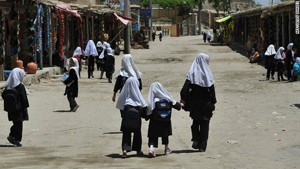By Daud Khan
On paper, it looks as if female education is alive and well in Paktia, a southeastern province of Afghanistan.
On closer examination, though, official figures show that three-quarters will drop out around half-way through their schooling.
The pattern is partly a reflection of an enduring prejudice against educating women, but sometimes the decision is based on real safety fears in this volatile province. The same is true of many other parts of Afghanistan.

Afghan girls walk to school in the village of Istalif, about 30 kilometers north of Kabul. (Photo: AFP/Getty Images)
Enrollment across Paktia province stands at 40,000 girls, but 31,000 of them are in grades one to five of the 12-year school system. This year, there are 120 in the final, 12th grade in the entire province. Only 75 finished high school last year, and 15 of those went onto higher education.
Jamila, a student in the sixth grade of a high school in the provincial centre Gardez, says her family moved there from Zazi Aryob district to allow her sister and her to carry on school. In their home area, she said, the community looked on female education beyond grades six to eight as something shameful.
As well as opprobrium from relatives and fellow-villagers, families say they have to weigh up the dangers to older daughters. There is the ongoing insurgency, but there is also the threat of abduction to settle scores between different Pashtun tribal groupings.
Aware of these issues, the education authorities run accelerated teaching programmes for girls. The programme head in Gardez, Mahera Ahmadzai, says girls who take part in it appreciate the value of it, and are bitter when they have drop out after the sixth year.
Daud Khan is an IWPR-trained radio reporter in Paktia.



